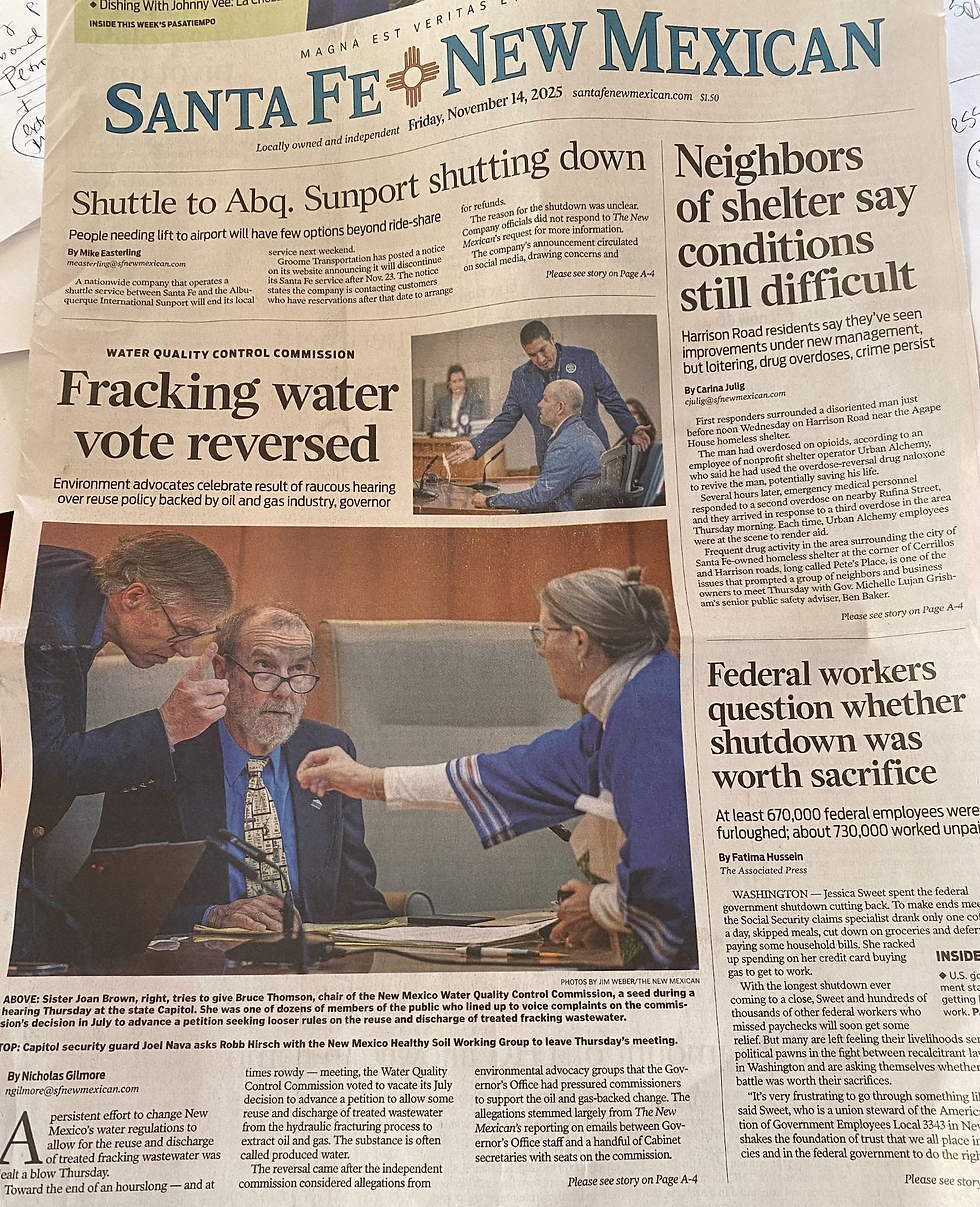What's next in the fight to oppose the Governor's Tragic Water Supply?
- New Energy Economy

- Apr 1, 2024
- 4 min read
According to Laura Capper, oil and gas industry consultant, “New Mexico needs to find new uses [for produced water] quickly or risk oil production itself.” - Hedden, July 12, 2023
The oil and gas industry in New Mexico has a problem. It’s not pressure from a Democratic State Government to reduce emissions - it's that our Earth Mother doesn't take kindly to toxic fracking waste injections. She responds with earthquakes! When oil and gas are extracted through hydraulic fracturing - aka fracking - in the Permian basin, each barrel of oil results in 4 -10 barrels of waste, often referred to as “produced water.” Produced water contains significant toxic contaminants known to severely impact human health, radioactive nuclides and, especially in New Mexico, extreme levels of salinity that, even if removed from the water, will result in a highly concentrated toxic and radioactive sludge that cannot be easily remediated. It is a hazardous waste and is not currently permitted for use outside of the oil fields.
In 2022, the oil and gas industry consumed 86,747 acre feet of fresh water and produced 266,160 acre feet of toxic fracking waste, aka “produced water.” This amount would fill 131,270 olympic size swimming pools! (BLM Water Support Document for Oil and Gas Development in New Mexico. 2023)
Under current law, oil and gas operators have two choices for disposal - re-use the produced “water” in drilling operations or inject the waste back underground into injection wells. Alternatively they can store the waste in evaporation ponds, ultimately resulting in a concentrated toxic sludge that is being trucked to landfills all over the state.
If the Governor and her biggest donor, the oil and gas industry, have their way, the door will soon be opened to another avenue for disposal of their toxic waste -- repackage it as water and sell it for use - aka the "Strategic Water Supply."
INJECTION WELLS INCREASED EARTHQUAKES IN NM TO 2,404 PER YEAR IN 2022
Unfortunately injection wells for the disposal of fracking waste are resulting in a dangerous increase in seismic activity- 2,404 quakes in 2022. This seismicity increased as oil production continued its steady rise to about 5.7 million bpd as of May 2023. Because New Mexico has never been earthquake prone, our buildings and infrastructure are not constructed to withstand those quakes.
And because New Mexico lacks capacity to dispose of all the waste it is producing, New Mexico has been sending about half of its produced water, at least 2 million barrels a day, into Texas for disposal. But in December 2023 the Texas Railroad Commission, facing its own earthquake dangers, acted to suspend permits for injection wells in Culberson and Reeves counties along the border of the two states.
The oil and gas industry in New Mexico now faces a costly crisis with no immediate solution. Gov MLG is trying to take the problem off their hands and place it squarely in our water.
THE NEXT BATTLEGROUND:THE PRODUCED WATER REUSE RULEMAKING BEFORE THE WATER QUALITY CONTROL BOARD
The Produced Water Act, legislation spearheaded by the oil and gas industry, passed the NM legislature in 2019 during Governor Lujan Grisham’s first year in office, opening the door to produced water re-use with the creation of the Produced Water Research Consortium, funded and populated by industry, and a permitting process for pilot projects to study the re-use of produced water outside the oil field. The director of the Produced Water Consortium, Mike Hightower, noted that the chokepoint created recently by the earthquakes has increased the pressure on the Consortium to move quickly. Upcoming rulemakings are being used to set definitions and permitting processes that will pave the way for produced water re-use in agriculture, on our roadways, and in our waterways. Those include:
Requirements For Water Reuse No. WQCC 23 - 84 (R) at the Water Quality Control Commission
Future Rulemakings at the New Mexico Environment Department about "water reuse" that might include "treated" produced water; brackish water desalination; reclaimed wastewater; commercial gray water; direct and indirect potable water.
Last Week New Energy Economy entered its Notice of Appearance in the first of these rulemaking proceedings to try to stop this madness.
Although funding for the Governor’s Strategic Water Supply proposal was defeated repeatedly at the legislature in 2024, the fight against this concerted effort by the Governor and her oil and gas industry donors has only just begun. The administration continued its related Request for Information (RFI) process to solicit industry feedback despite the lack of funding. New Energy Economy joined advocates and organizations across the state in submitting a response detailing the dangers of the Strategic Water Supply.
The Strategic Water Supply proposal represents the nexus between energy and water policy. Oil and gas operators in Texas have admitted that the scarcity of disposal wells has already led them to “slow down oil and gas drilling.” We must ensure that produced water remains illegal for re-use outside the oilfield, putting pressure on our elected leaders and the oil and gas industry where it counts, to ensure that our precious sweetwater aquifers, our rivers, lakes and the acequias that every New Mexican relies on will be protected from contamination. Once a well is poisoned, it is gone for good.
The Governor is committed to finding a path to dispose of the oil and gas industry’s toxic waste by hook or by crook, and the fight to protect our water will require vigilance and perseverance during the remaining three years of this administration and beyond, both at the legislature and through administrative rulemaking.










Comments